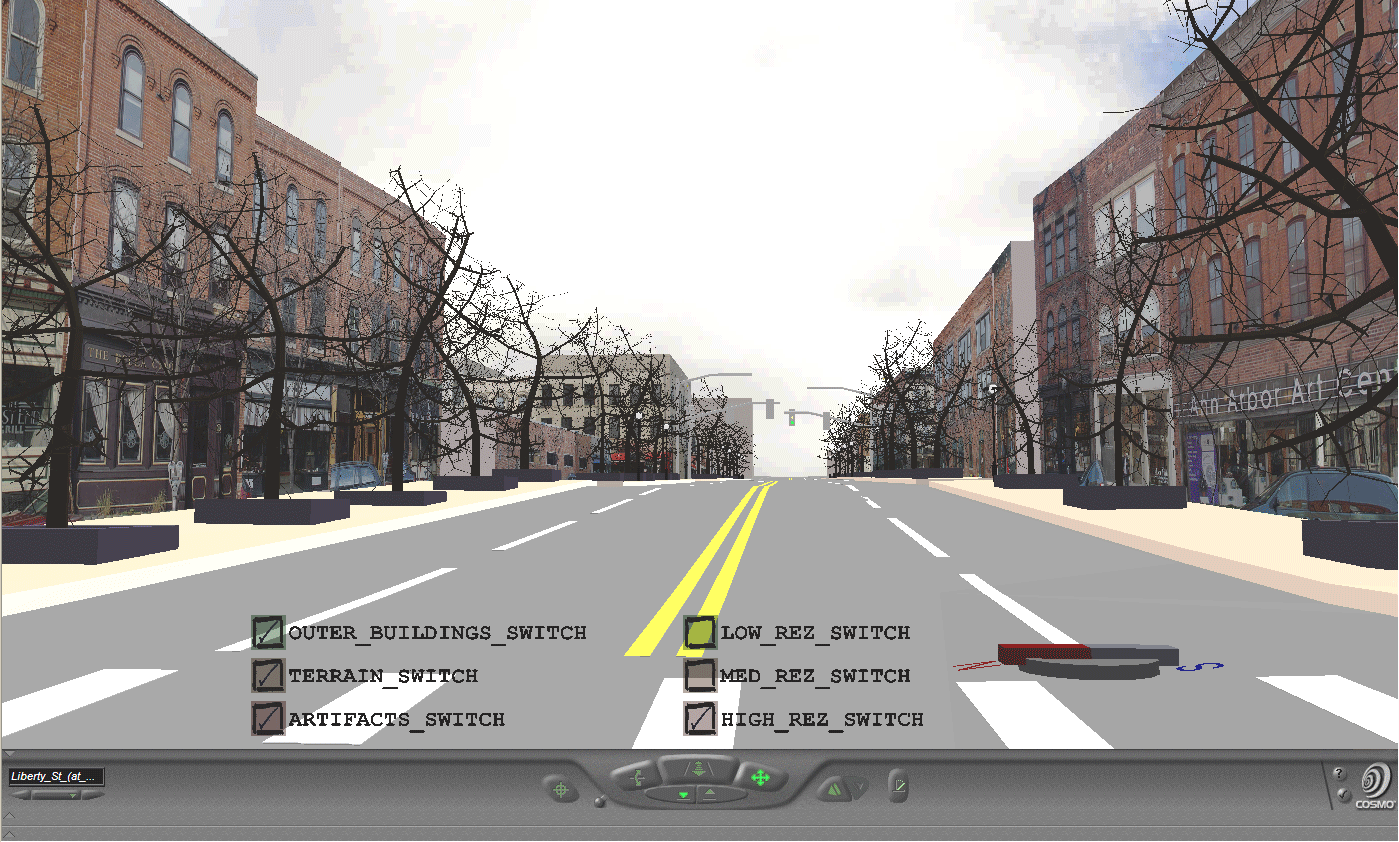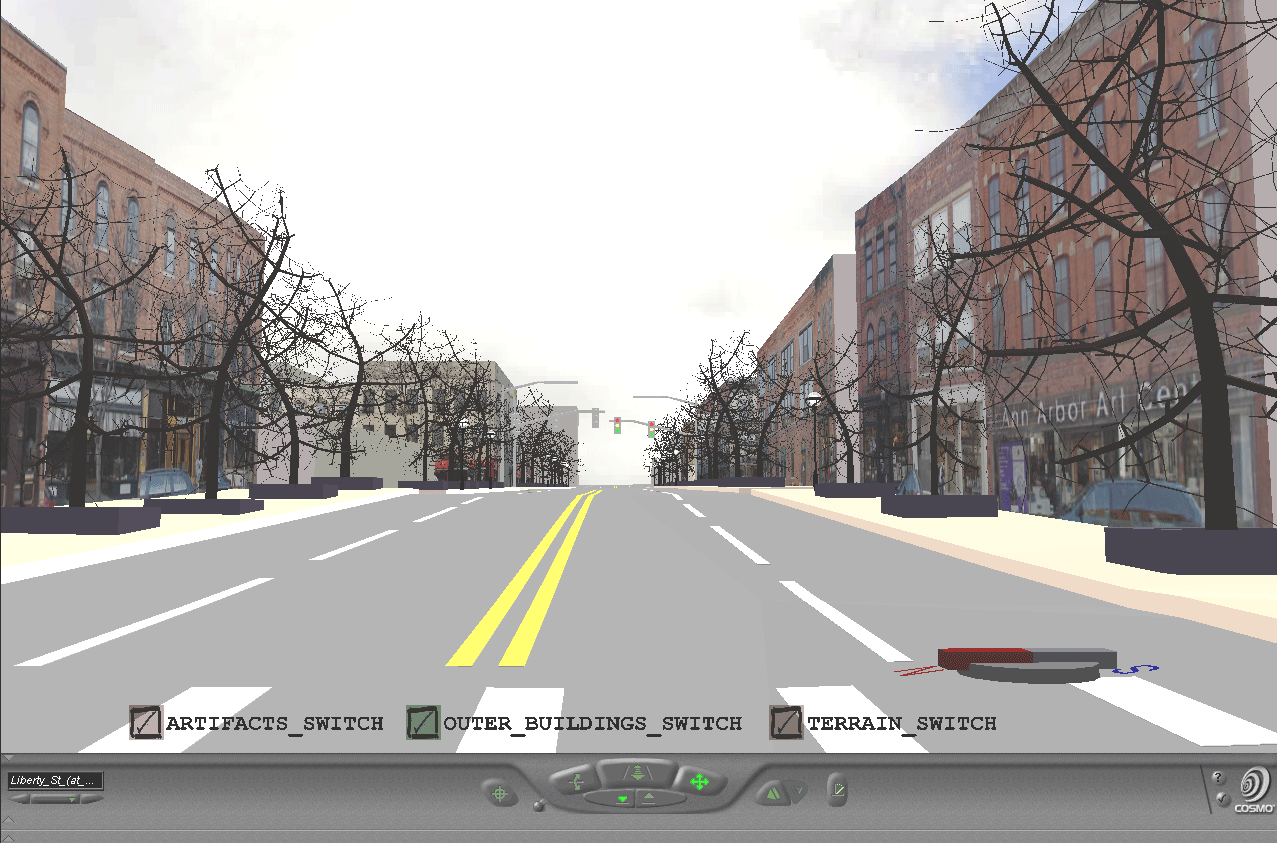One Optimization of an Earlier Model of Virtual Downtown
Ann Arbor
Klaus-Peter Beier*
The University of Michigan
In Ann
Arbor, Michigan: Virtual Downtown Experiments, Part III, Solstice,
Vol. XIII, No. 2, the authors, Kwon, Lazzaro, Oppenheim, and
Rosenblum, portray a useful virtual model of four blocks of downtown Ann
Arbor. The file size of their model is, however, quite large:
40 MB. This article iillustrates one way to reduce the size of that
file and, consequently, load time. The newly optimized file is now
8 MB which is useful to a wider audience than is the previous file.
The appearance of the two files does not differ greatly; what does differ
is load time. Figure 1 below shows a screen capture from the 40 MB file
set at High resolution; Figure 2 below shows a screen capture from the
8 MB file set at Medium resolution and modified as noted below. The
optimization for improved load time does not make a noticeable difference
in visual appearance. Figure 3 shows the edited 8 MB vrml file embedded
in the html (requires that Cosmo Player or Cortona be pre-loaded in the
browser; both are free downloads).

Figure 1. Screen capture from the 40 MB file set at a
viewpoint, zoomed in on, and lightened in Adobe Photoshop (trademark, Adobe).
Link
to VR file: requires Cosmo Player plug in to browser (IE or Netscape
4.x) or Cortona from Parallel Graphics (free download). |

Figure 2. Screen capture from the 8 MB file set at a viewpoint,
zoomed in on, and lightened in Adobe Photoshop (trademark Adobe). Link
to VR file: requires Cosmo Player plug in to browser (IE or Netscape
4.x) or Cortona from Parallel Graphics. This linked file is also
shown embedded in the html, below. |
Figure 3. Edited file. Try looking at the model
from different viewpoints or navigate, on your own, using the control panel. |
Still, the application is big and runs slowly (low frame rate) if the
most advanced graphics board is not available. The culprit is the artifacts
file. The artifacts (trees, lamps, benches) are over-defined (too many
polygons). Also, exhaustive field checking is a recommended future
step to remove any error in detail in the scene as compared to reality.
The appendix to this document, made from notes, shows the modifications
made to the files.
APPENDIX
Removed option for low-res and high-res textures, using only med-res
textures.
This eliminates all jpg files for high and low res.
Changed all file types to lower case (e.g. WRL -> wrl)
Removed all instances of Lamp (43 lamps) from artifacts.wrl
Created Inline file for lamp: LAMPUS.wrl
Created prototype MyLamp using Inline file
This reduced the size of artifacts.wrl
Same for 46 trees
Same for 7 benches
Removed all TimeSensors connected to trees (no need)
Modified many instances of "solid FALSE" to "solid TRUE"
Removed invalid color in Lamp
Removed reference to non-existing texture REKKANIG.BMP
Cleaned up ROUTING and Script
Set "collision FALSE" for all artifact.wrl objects
Improved navigation, added useful viewpoints
----------
Professor Beier, Ph.D., is Director of the 3D Laboratory of The University
of Michigan Media Union
----------
Solstice: An Electronic Journal of Geography and Mathematics,
Institute of Mathematical Geography, Ann Arbor, Michigan.
Volume XV, Number 1.
http://www.InstituteOfMathematicalGeography.org/

